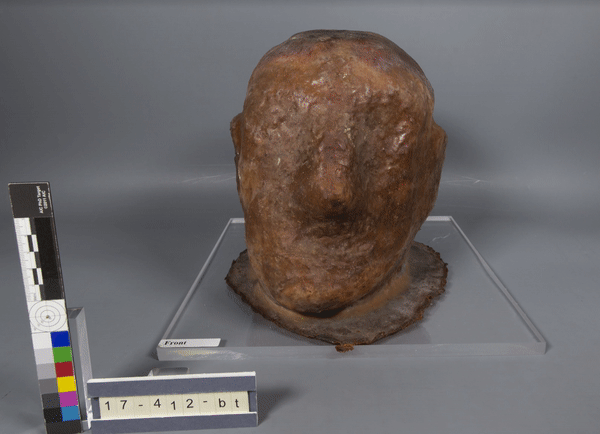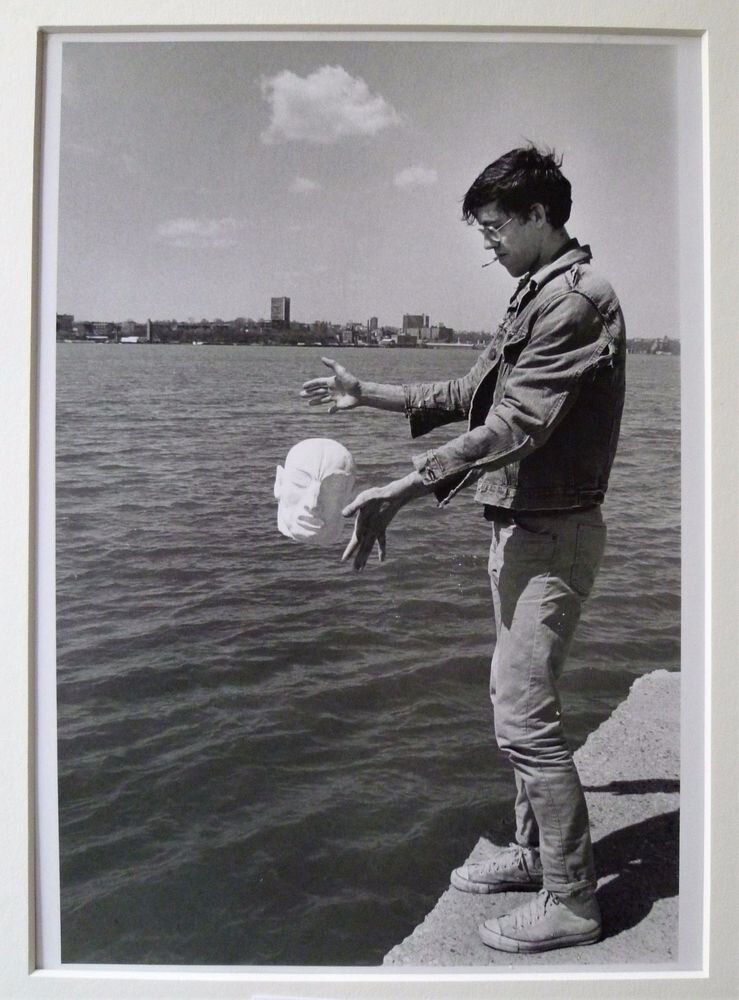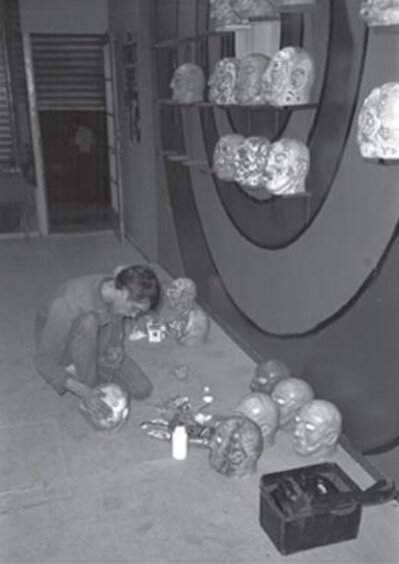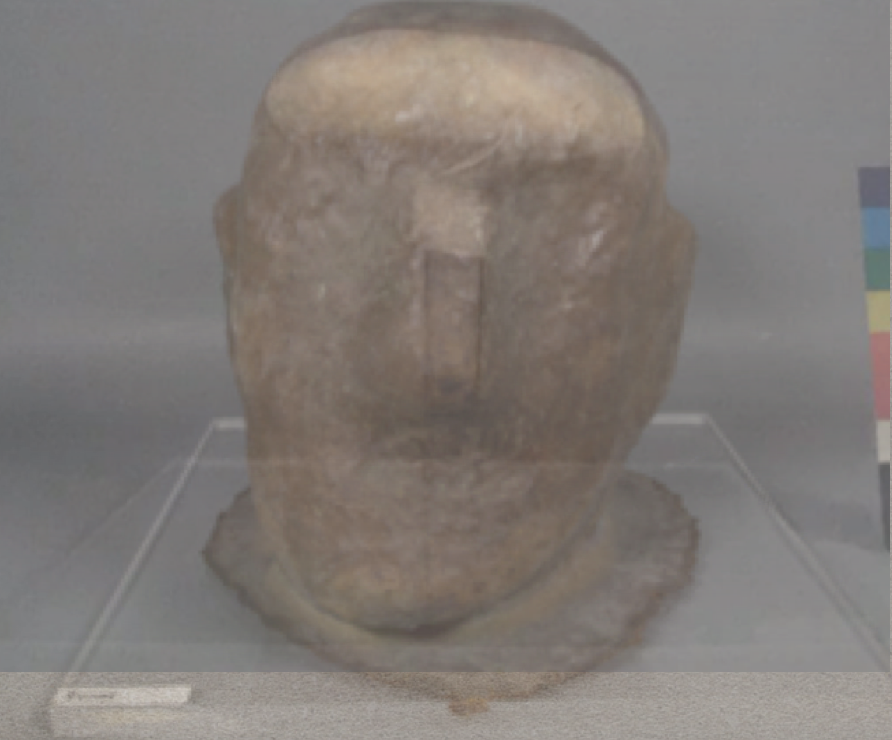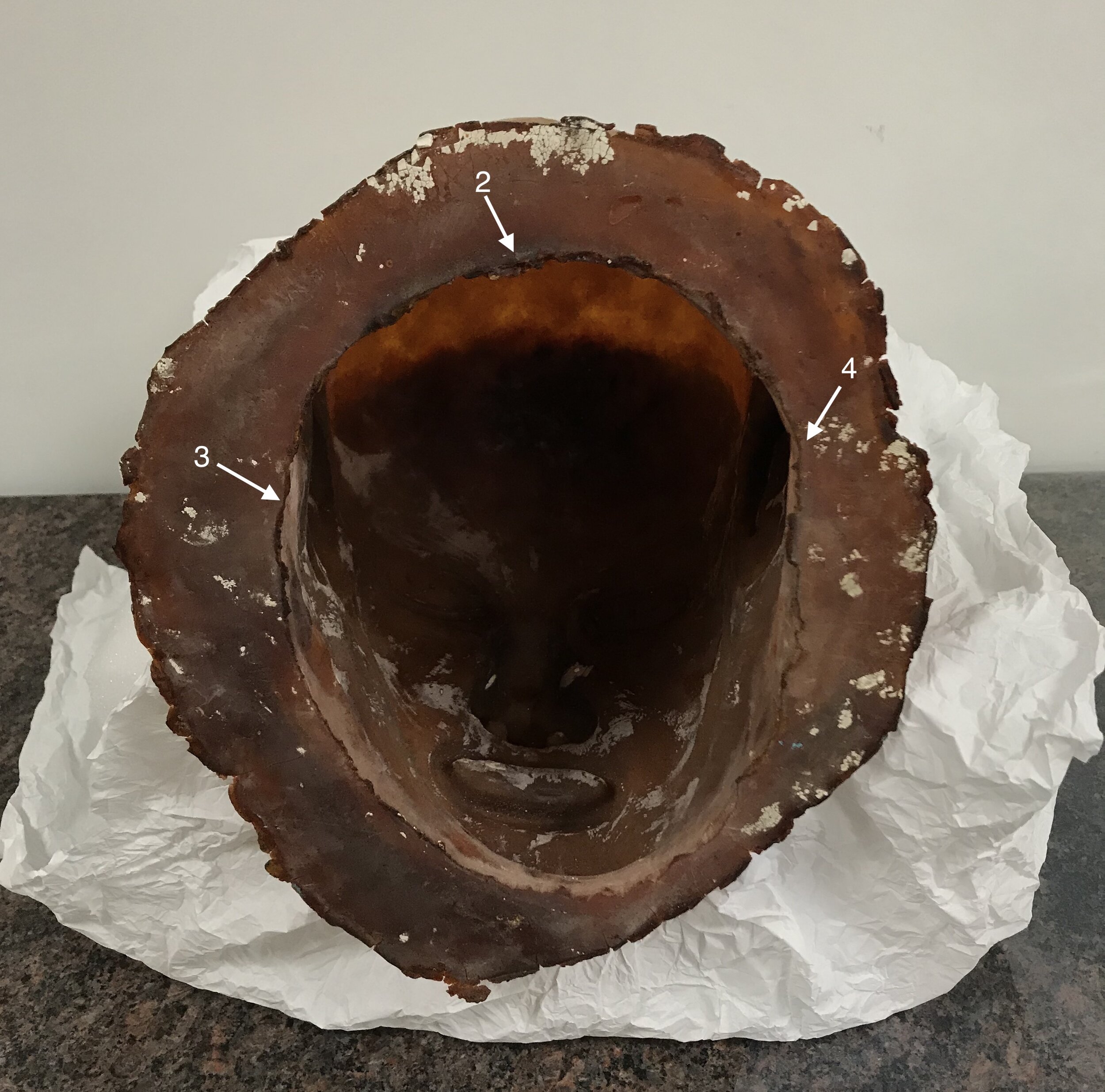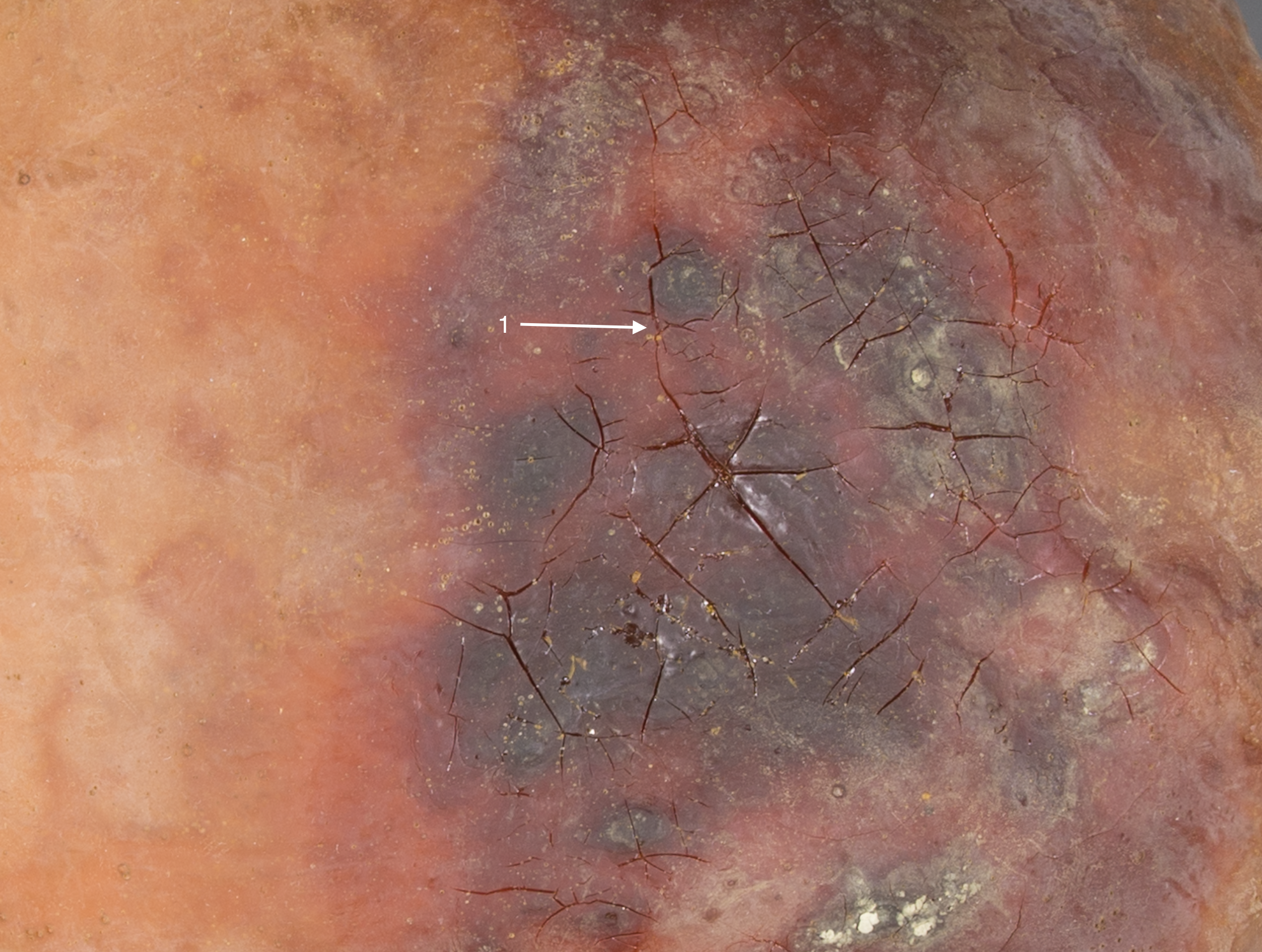Investigation of a Sculpture Mold by David Wojnarowicz
Head Mold, David Wojnarowicz, 1984. 092.0360
David Wojnarowicz (1954-1992) was an American artist who worked in a wide range of media, including painting, sculpture, printmaking, writing, and film-making from an early age until he died of AIDs-related complications. The artist’s archives were acquired in 1997 by NYU’s Fales Library and Special Collections and include his papers, films, photography, videos, audio, ephemera, and production materials, including a flexible mold used to create plaster-cast head-forms for his sculpture series, Metamorphosis (1984). The once-flexible material had become alarmingly brittle and discolored, had fused to the Plexiglas underneath, and exhibited major deformations. This housing orientation unintentionally catalyzed degradation and limited viewers’ access to the details of the mold on the interior. A multifaceted project was designed to identify the mold material, document the present condition, and develop preventive conservation strategies for this archival object. It involved the use of 3D scanning as a method to create more suitable housing, and comprehensively document the deteriorating mold.
Condition Issues
In 2006, structural stabilization was attempted with an internal support suspending the degraded mold over a Plexiglas base. In conversation the supervising conservator Jessica Pace, Preventive Conservator at NYU Libraries this object was selected as a candidate for rehousing.
Left: Internal Mount created in 2006
Right: Overlay showing the position of the internal mount
Additionally, the localized stress created by the mount seemed to be catalyzing degradation at the crown. We can see the drastic increase in discoloration and cracking at the crown as the rubber slumped and shrank. An urgent issue was to remove the mold from its plexiglas base and provide adequate support. The once-flexible mold was also alarmingly brittle and discolored. It sagged, and bonded to the Plexiglas underneath through contact and gravity over the years. It became an urgent issue to remove the agent of degradation: the internal mount.
This orientation obscured its function as a process object.
Top and bottom left: documentation images from 2006; Right: documentation of advanced degradation from 2018
Below are the results of material identification using techniques such as instrumental analysis and archival research. The identification of the material informed preventive conservation decision-making which involved an adaptation of an experimental housing and documentation strategy. This involved 3D scanning of the mold’s hollow cavity and exterior that served a dual purpose. This involved 3D scanning of the mold’s hollow cavity and exterior that served a dual purpose. First, the 3D scan was used as a model for the creation of a custom external storage support created using a CNC milling machine. Second, the scan provided comprehensive documentation for the rapidly deteriorating surface. Viewers can now see the details inside in its new housing, and additionally as a virtual model. and understand the mold’s value as an intermediary process object—highlighting its connection to the sculpture series. During this project, several exciting applications of 3D scanning were discovered and are described in this paper.
Rehousing
3D scanning was used to rehouse the object to minimize further degradation and document the deterioration that has already occurred. This involved a collaboration with NYU’s Laguardia Studio, a co-op that provides advanced digital media services including 3D scanning to NYU faculty, students, and visiting artists. The studio’s scanning technician, Taylor Absher came to the lab and 3D scanned the exterior surface of the mold. The scanner captured surface information in real time on the connected laptop. The scanner produced a set of data points in space that represent the surface of the object, called the point cloud. Those points were automatically connected by vectors into a 3D surface, or geometry.
This information was used to create a digital model for rehousing. Both the conservation and curatorial departments agreed that an upside down orientation both distributed the strain on the material as well as exposed the interior cavity for educational purposes. This storage solution would be executed through CNC routing, a computer-controlled cutting machine that can mill various materials including foam.
The .stl was imported into Partworks 3D, a dedicated toolpath software for CNC machining of three dimensional models. The dimensions of the model and material were defined in this program. Additionally the parameters of the machine were input to calculate the path that the CNC machine takes to cut the foam in 3 dimensions.
Taylor Absher 3D scanning the exterior of the mold
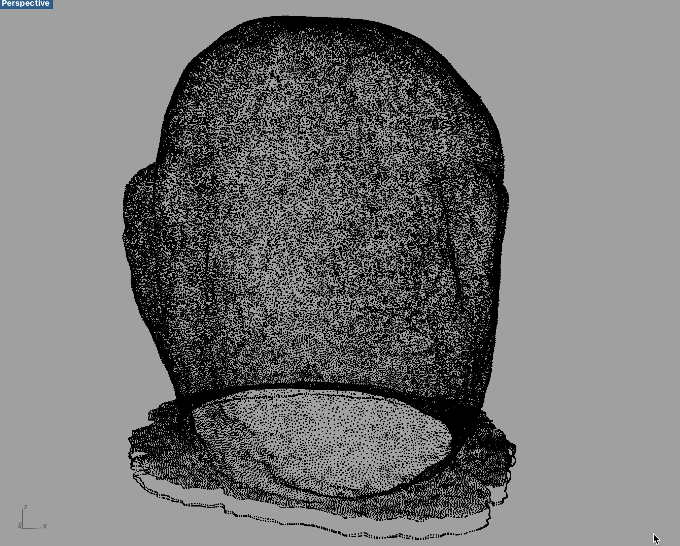
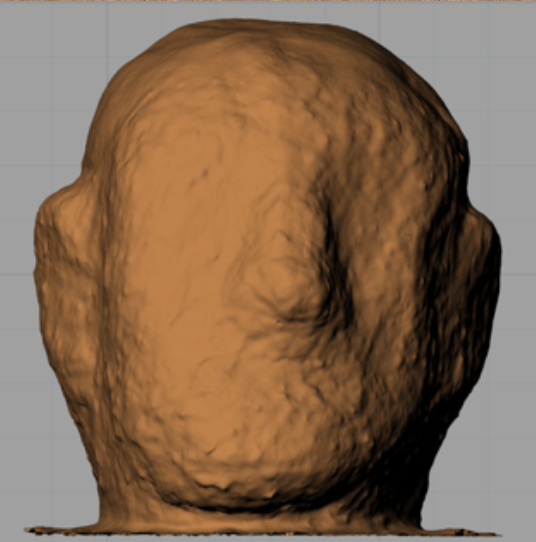
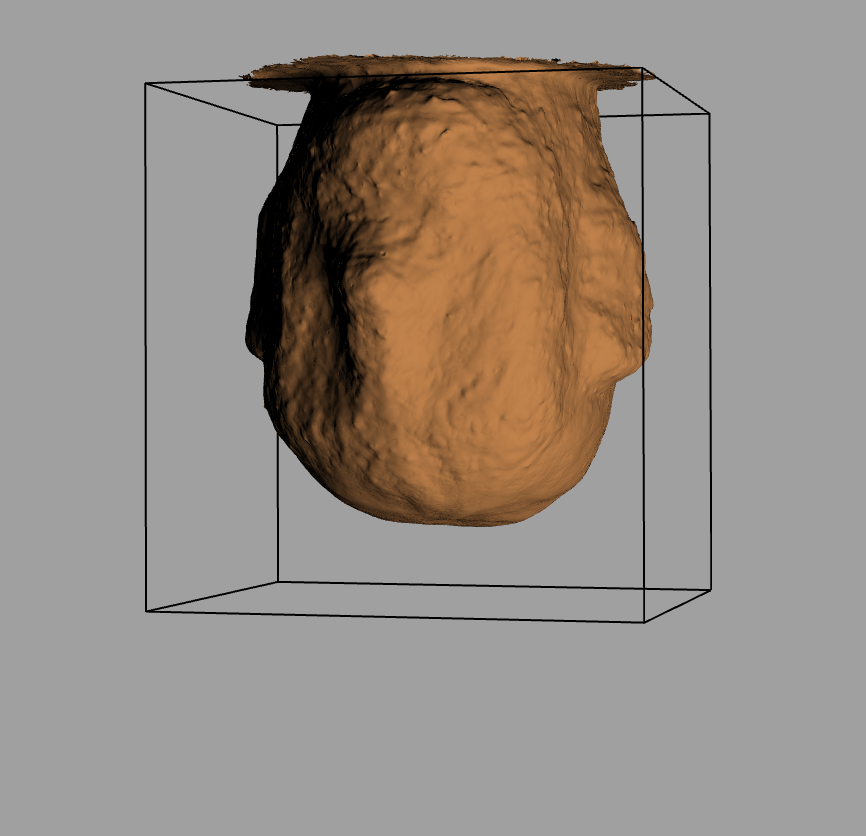
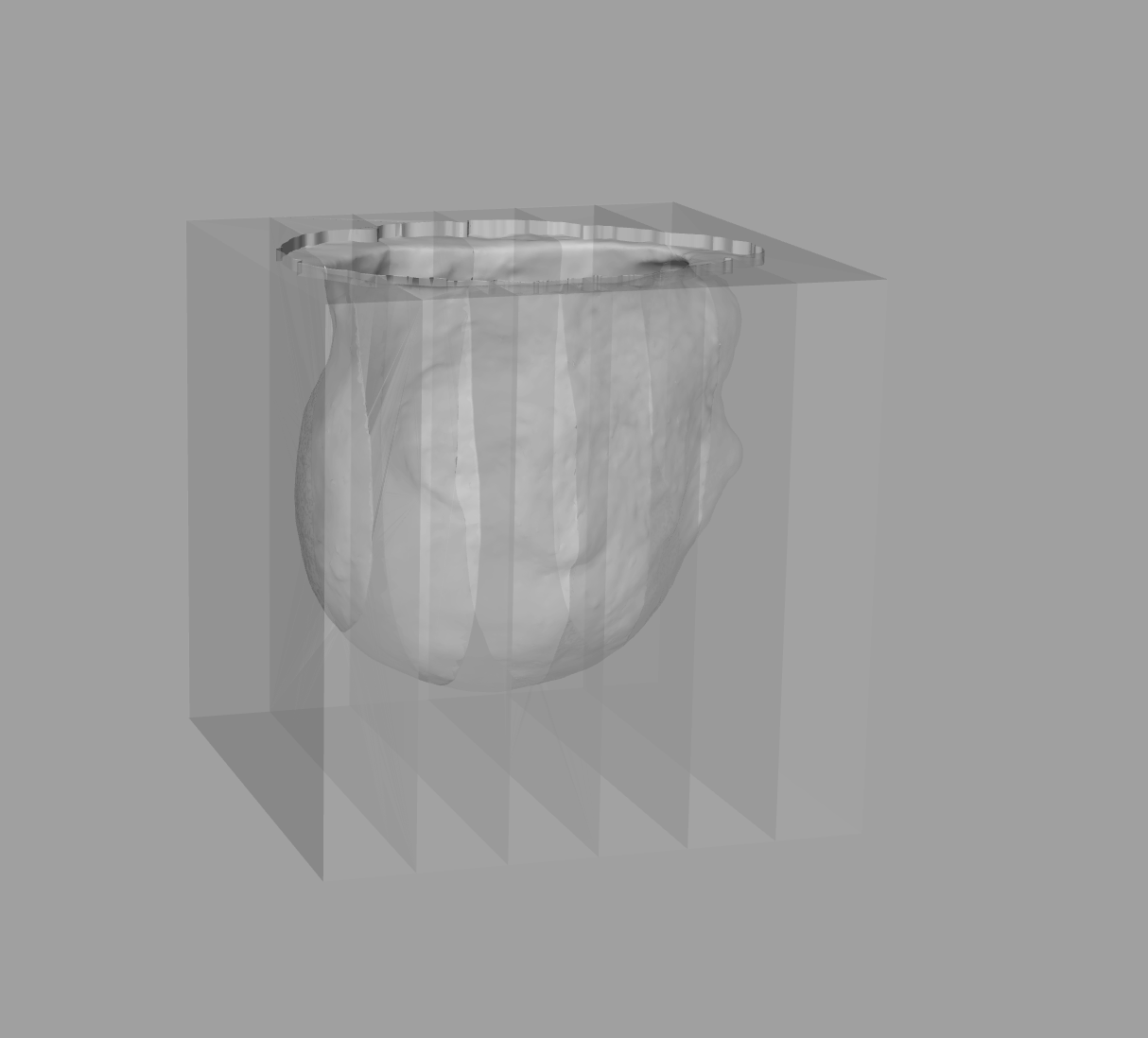

video of the CNC router cutting out the slice modeled in Rhino
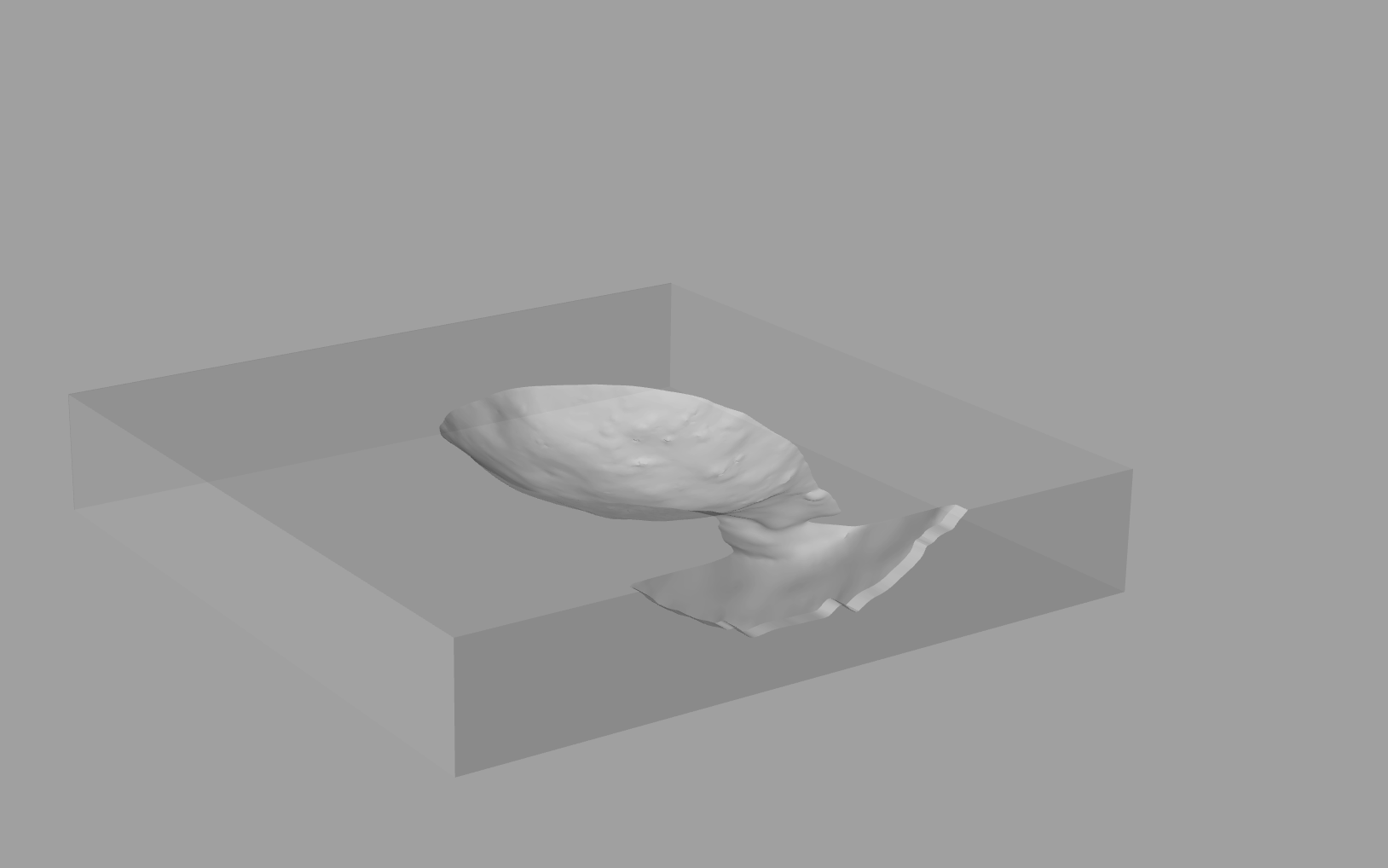

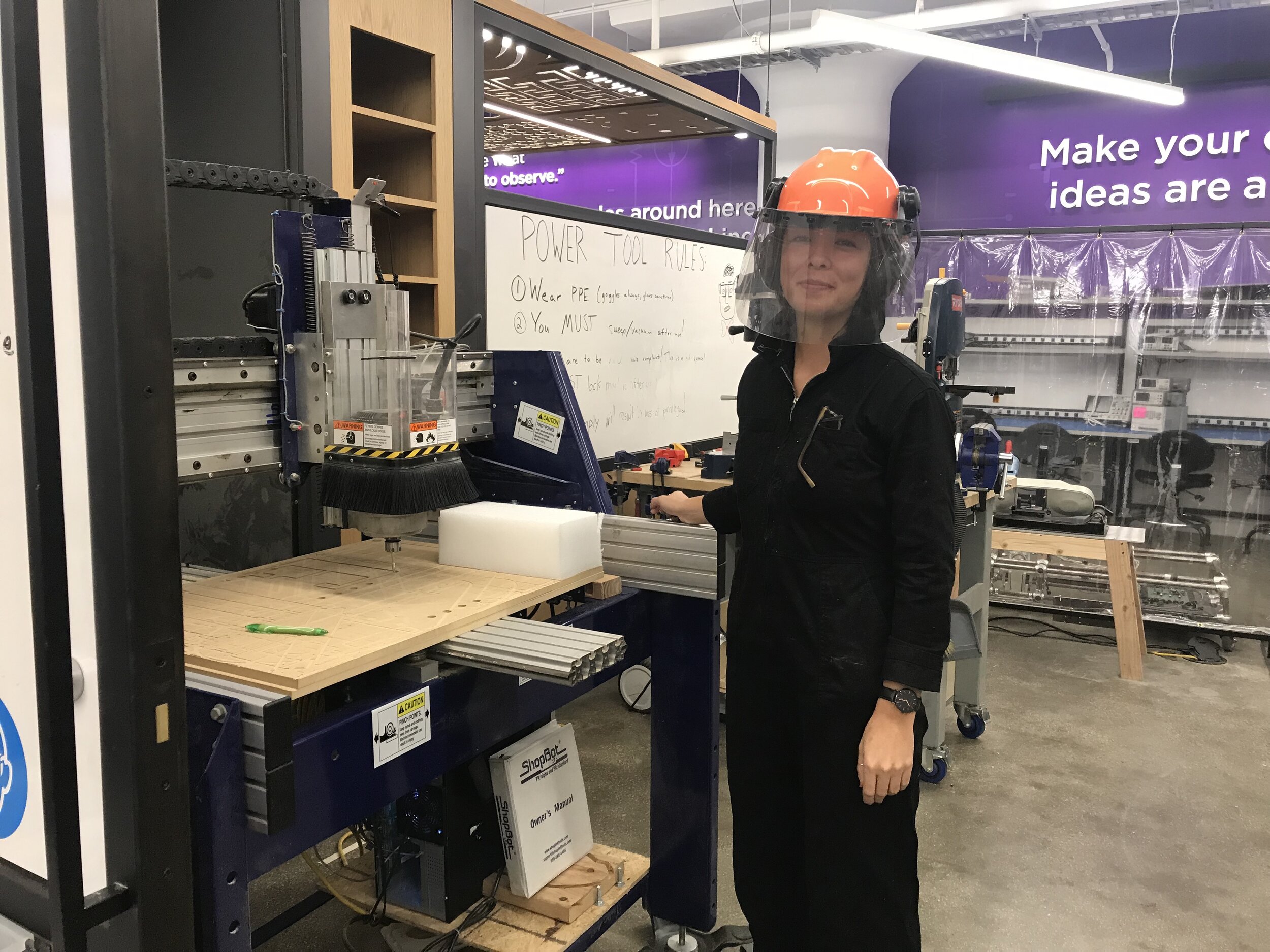
Slice modeled in Rhino; g code excerpt; CNC machine at Tandon
Box and clamshell supporting the mold in an upside down orientation.
NYU’s Tandon school of Engineering makerspace facilities had a 3 axis CNC router, an adequate tool for this rehousing fabrication job. The CNC machine, essentially a drill bit running on a XYZ axis is controlled through g code, a widely used numerical control programming language, an excerpt from the thousands of lines of coordinates and commands defined in Partworks. After the sections were cut, they were adhered with 3M hotmelt glue to create a clamshell form. There was a barrier layer of polyethylene sheeting that was heat-formed to the cavity. This provided an adequate support for the mold to lay face down once removed from its plexiglas base. The clamshell was placed into a blue board box with a window in the lid that gives access to the interior of the mold. There are fold-away walls, which allow for easy removal of the form.
Material Identification
Richard Kern’s American Obsessions records the artist mixing and pouring plaster into a flexible mold and violently ripping it off to reveal one of the cast head-forms for Metamorphosis.
Richard Kern, still from “American Obsessions” 1983. Featuring David Wojnarowicz. Super 8 color on digital video, silent. 1:21 min.https://vimeo.com/111685801 password: ppow535nyc
Material identification was approached in two ways: through archival research and scientific analysis.
Archival Research
The first place to turn to for information was the David Wojnarowicz Knowledge Base, an Artist Archive Initiative at New York University. This interdisciplinary resource centralizes an array of information gleaned from the artist’s archive and makes it accessible through an open-source platform, MediaWiki. The Knowledge Base was invaluable for identifying PPOW Gallery as Wojnarowicz’s gallery representation. The director of the gallery was grateful to be informed of the research into this flexible mold, and shared an underground film by the artist’s friend Richard Kern. A scene transported the viewer to Wojnarowicz’s hellish kitchen-turned-studio. This chaotic experimental film records the artist mixing and pouring plaster into a flexible mold and violently ripping it off to reveal one of the cast head-forms for his work Metamorphosis. A work of art in its own right, the film also offers unmatched evidence of the mold as an active agent in the making of the series; it is shocking to see the strength and flexibility of the un-aged mold material, especially given its current deteriorated state. The documentary video was also examined frame by frame, in hopes that a label would appear bearing the name of the commercial mold-making material. Unfortunately, none was evident.
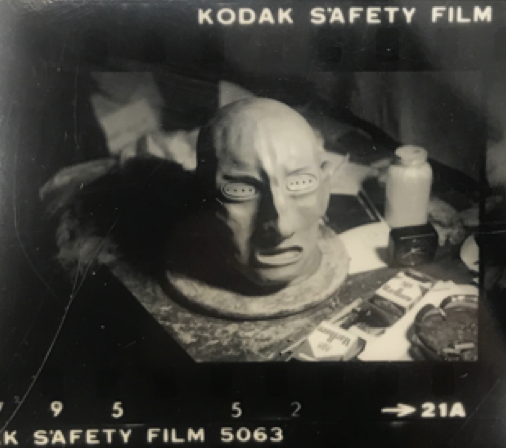
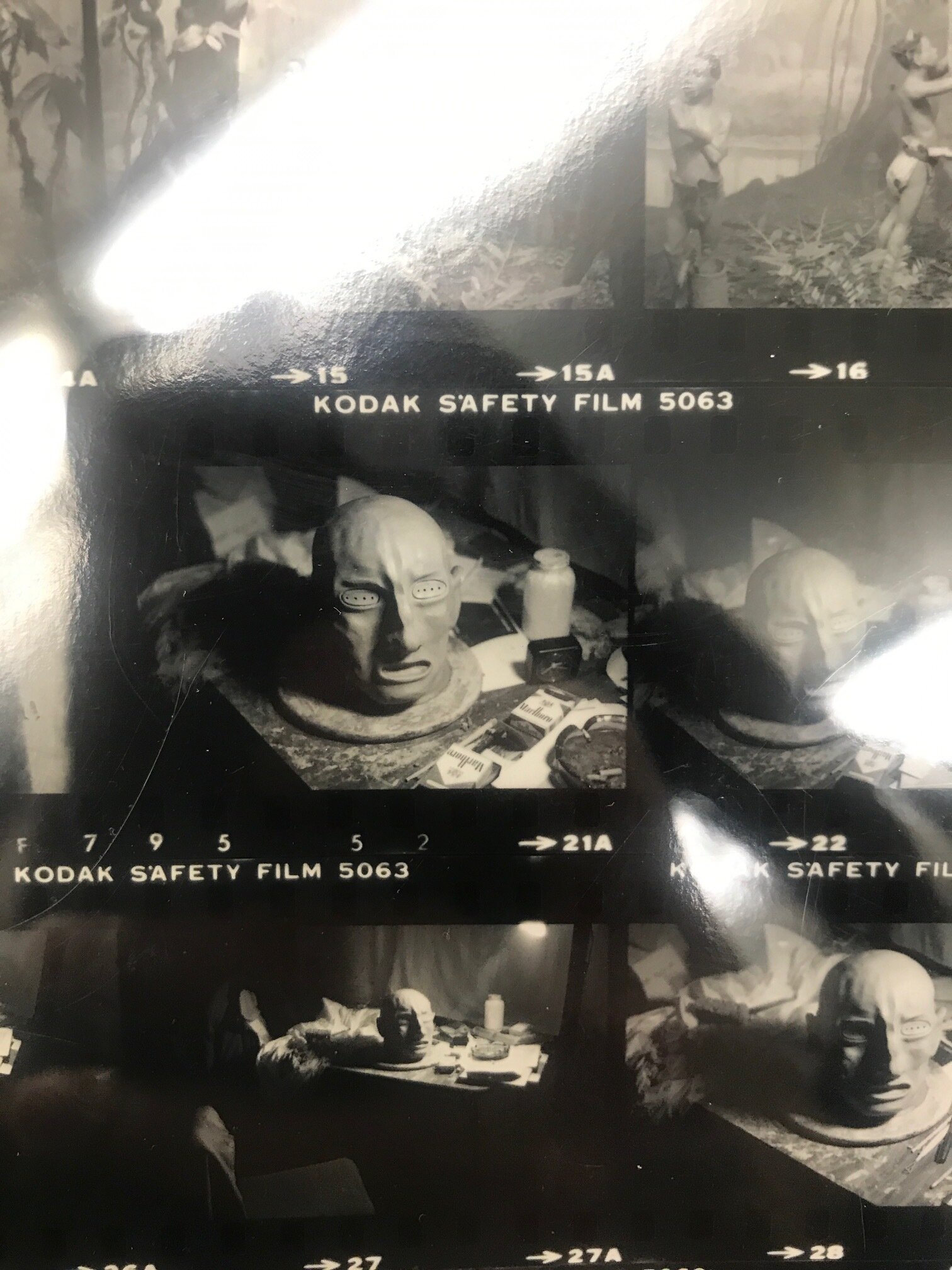
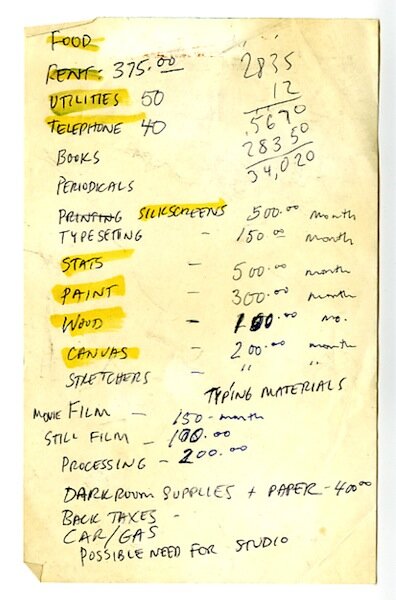
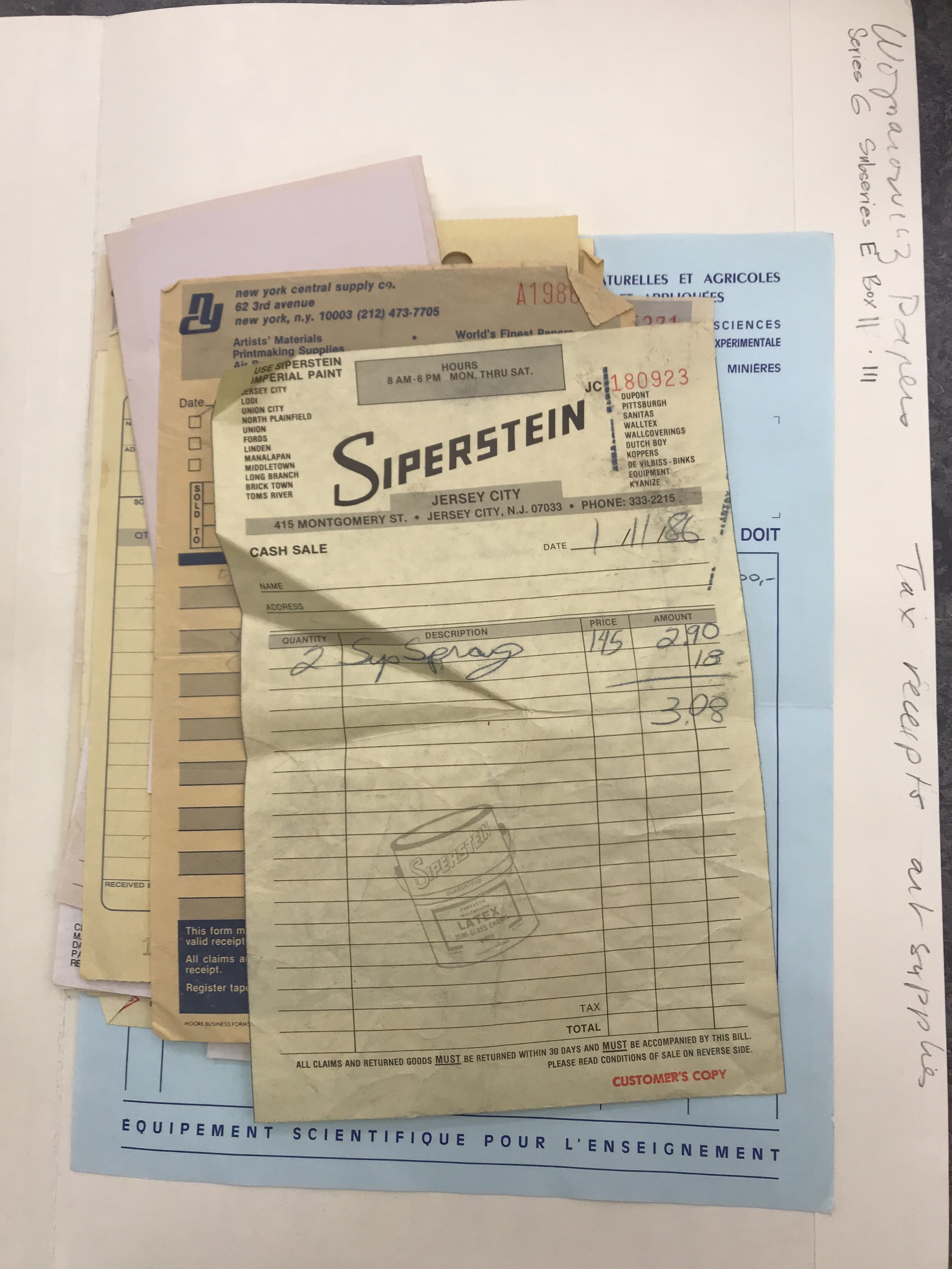
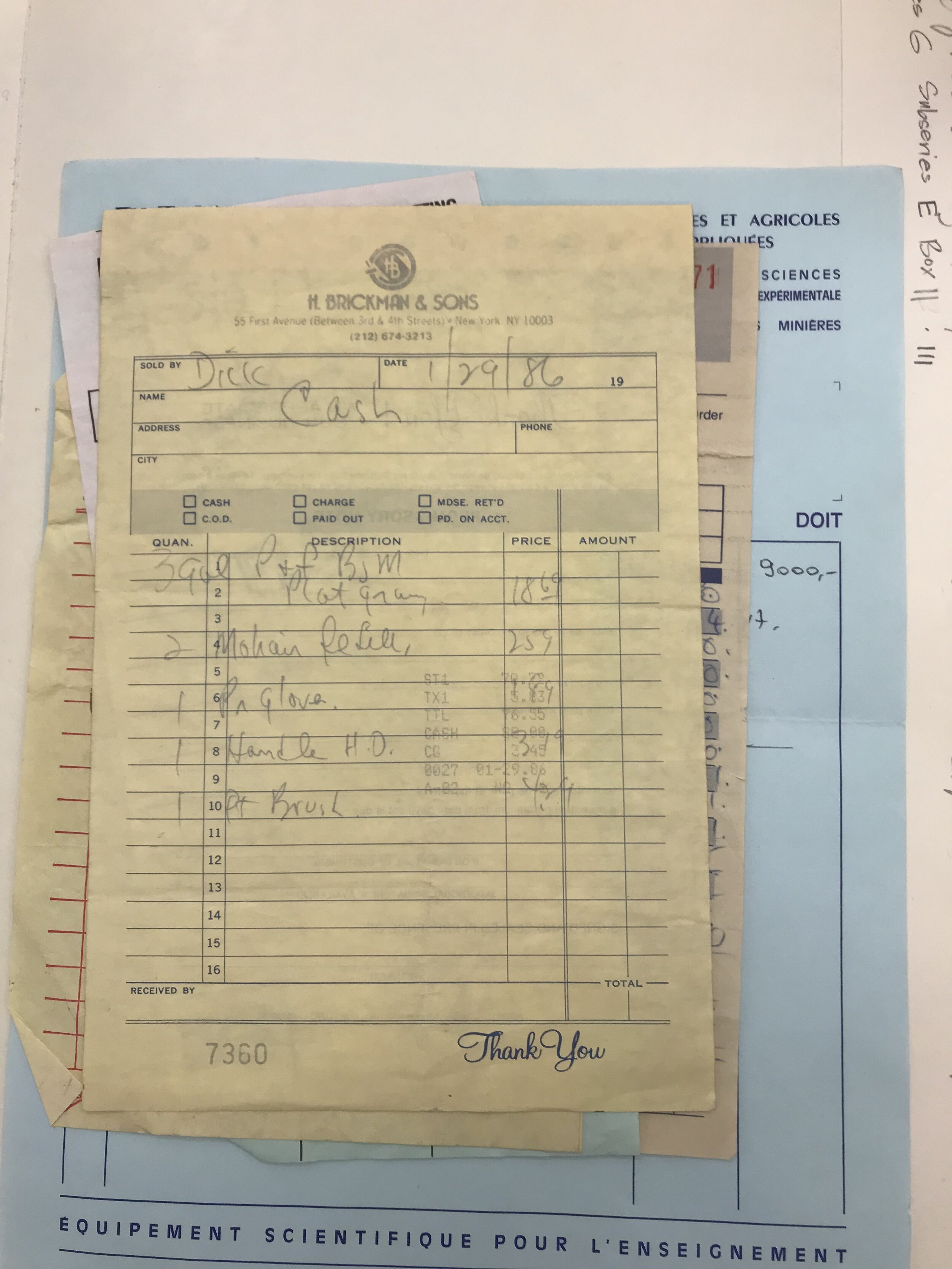
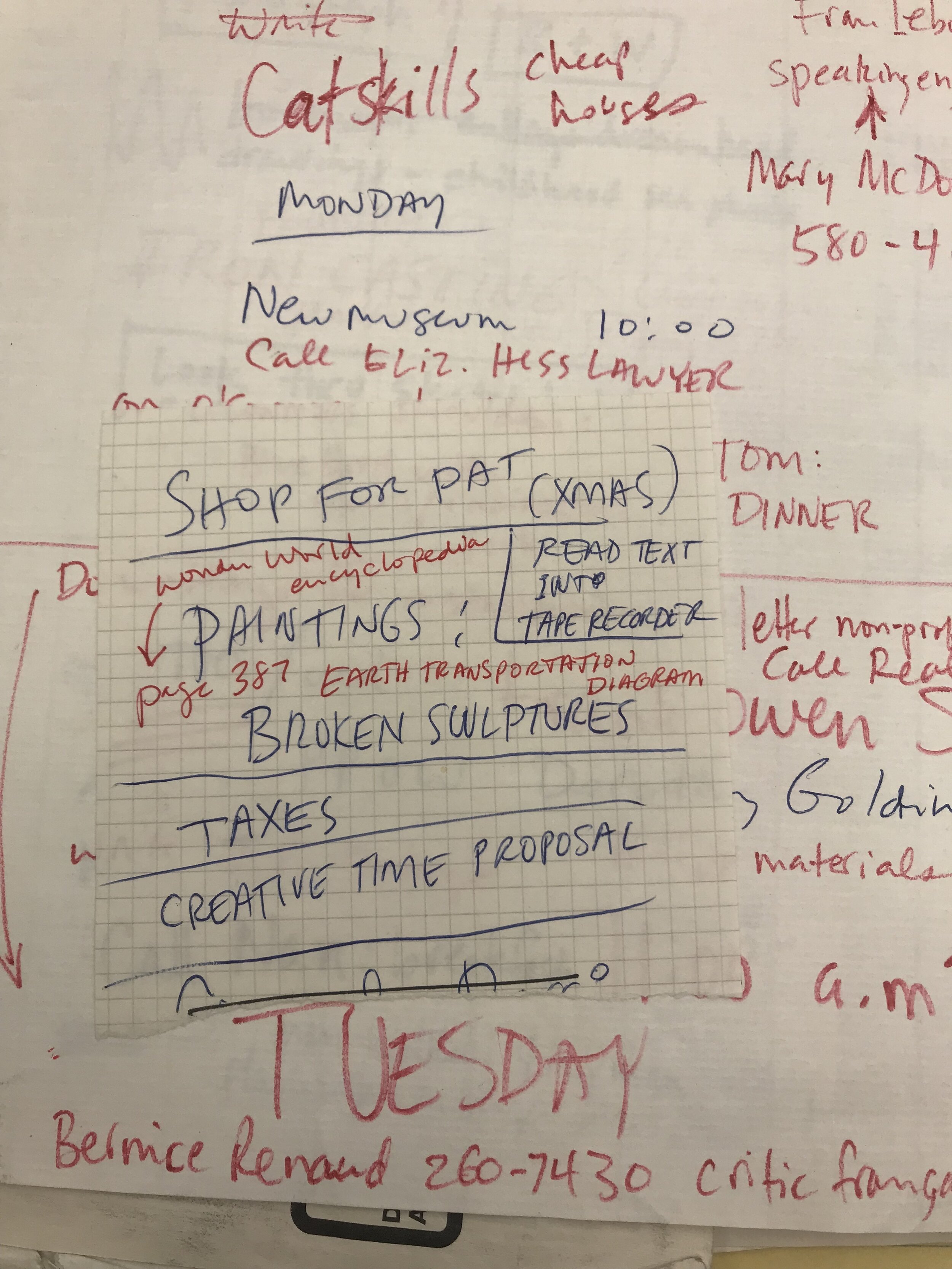
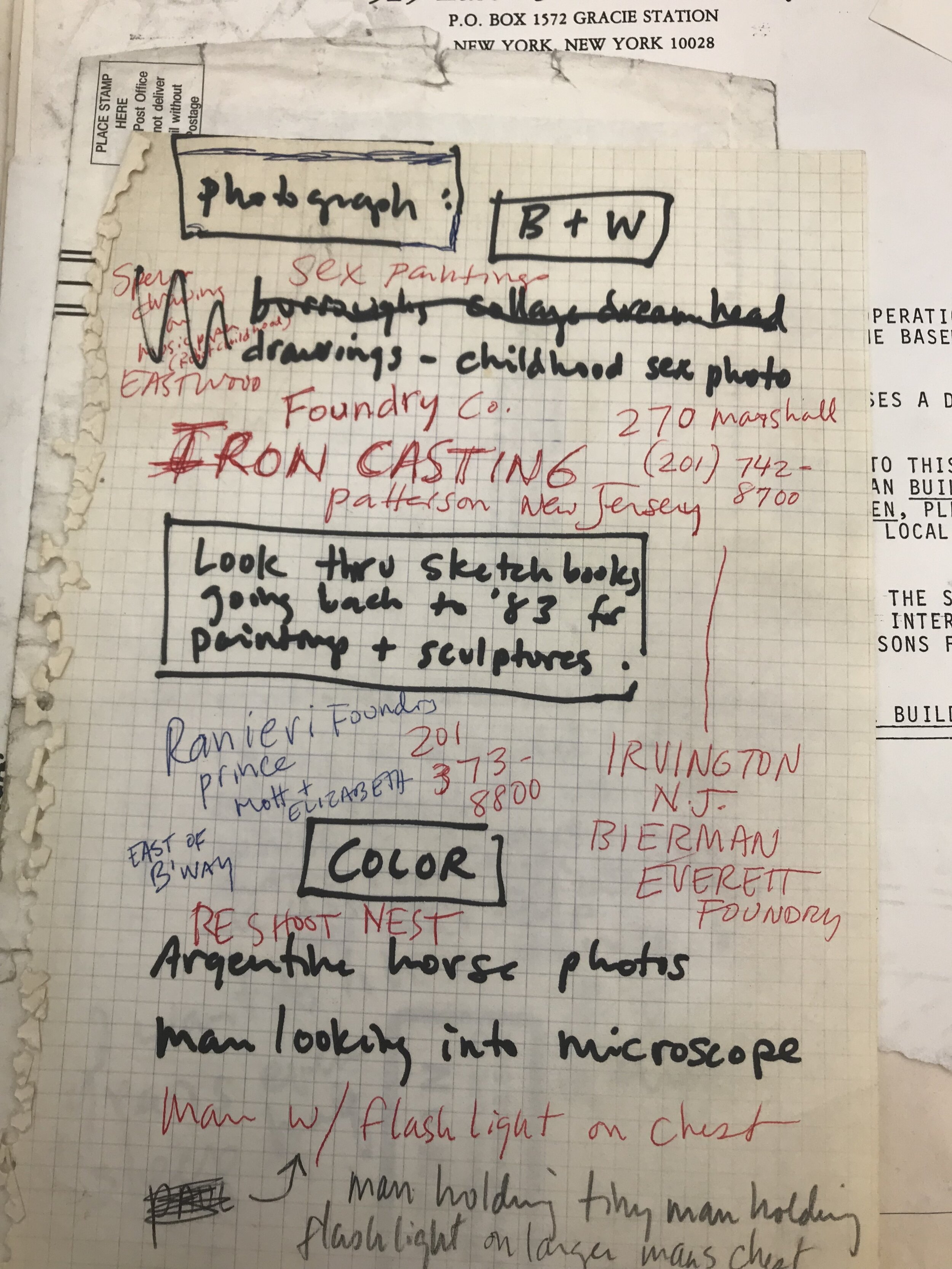
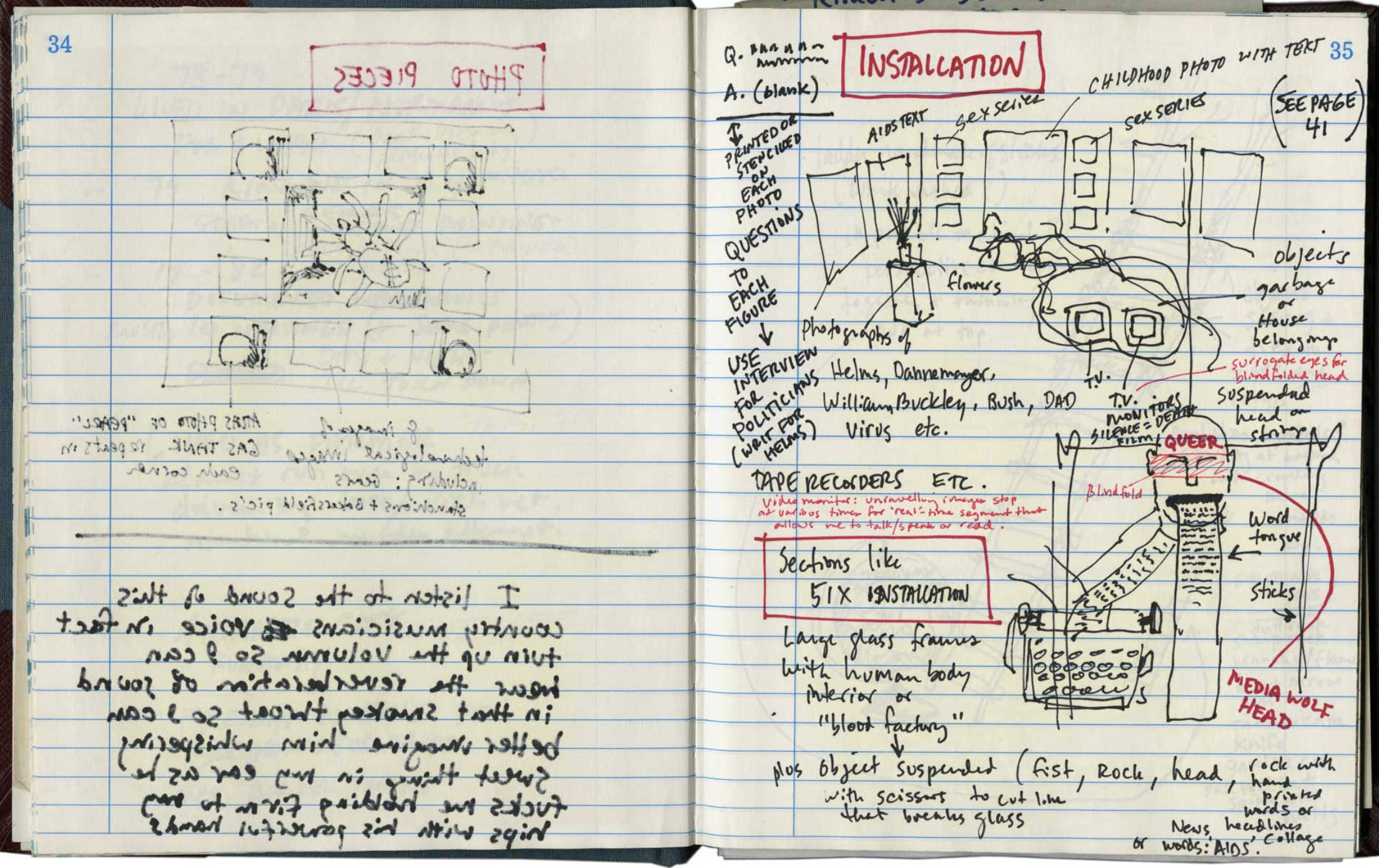
The search continued by combing through David Wojnarowicz’s papers which were immediately available at Fales library. The David Wojnarowicz Papers included the artist's writing, film, photography, video, audio, ephemera, and process materials, including the flexible mold used in the making of the Metamorphosis series. The nearly 175 boxes in the collection held the artists’ shopping lists for art materials, undated chaotic to-do lists and sketches, thousands of documents including receipts from art supply and hardware stores and journals where he meticulously planned his works. Although it was a powerful experience sifting through the documented vestiges at the forefront of the artist’s creative processes, and photographs were discovered that give insight into the production of the mold, the proprietary name of the mold-making material was never revealed.
Scientific Analysis
Because the written reminder, receipt, or image of “1 quart of such and such mold-making material” was never found, scientific analysis was then conducted to identify the composition and characterize the degradation process of the mold material. Techniques such as Fourier Transform Infrared Spectroscopy (FTIR) and Pyrolysis - Gas Chromatography Mass Spectrometry (Py-GCMS), are common methods of polymer and elastomer analyses, and in this case, required sampling.
Sample sites
However, a mold presents the issue of sample retrieval: removing material from the interior would destroy the surface that actually created the artwork. But also removing material from the exterior would be noticeable. Following these considerations, the curators allowed me to sampled from the the top of the exterior, at the site of greatest deterioration as well as the least degraded excess material around the interior ring.
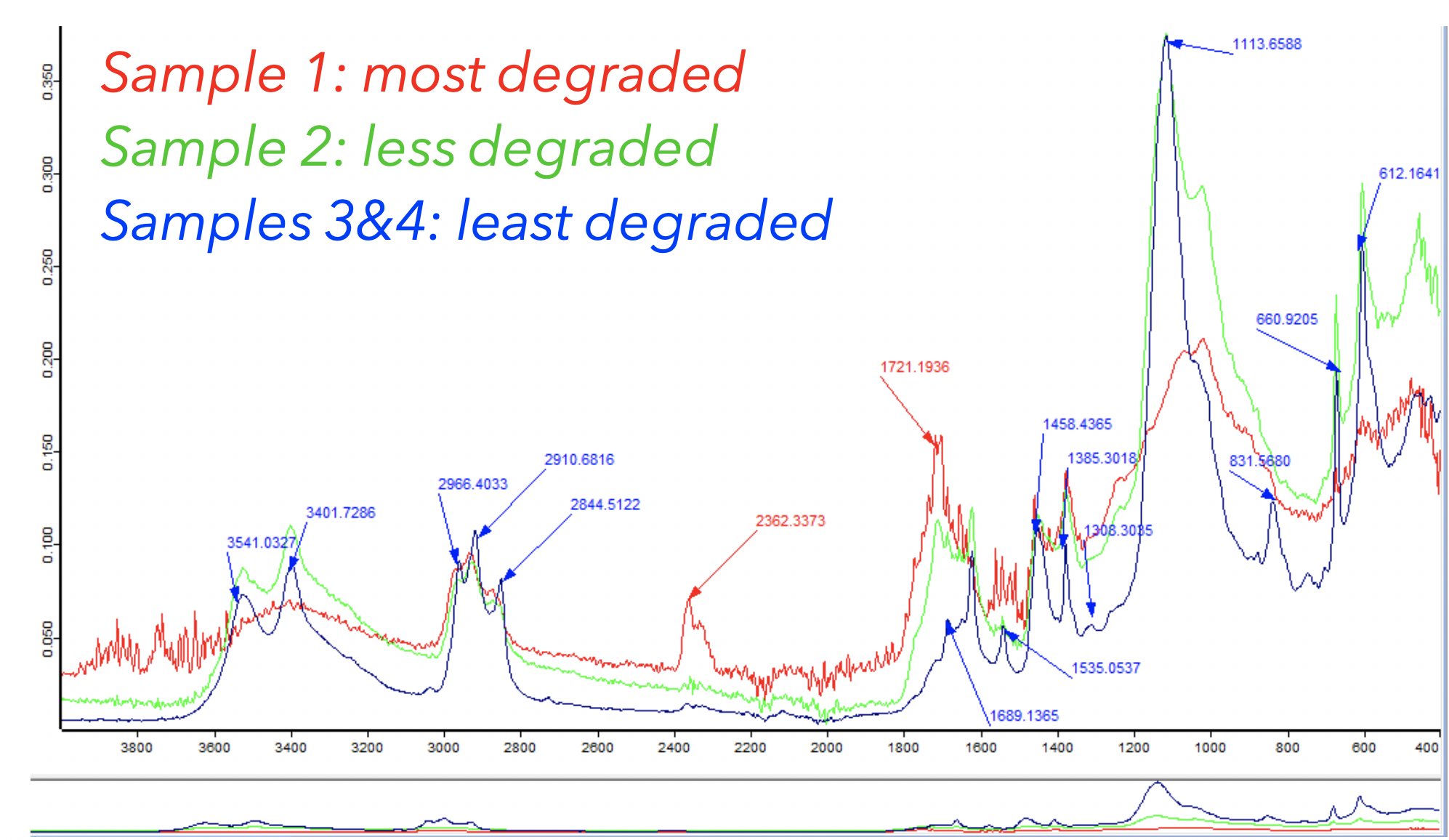
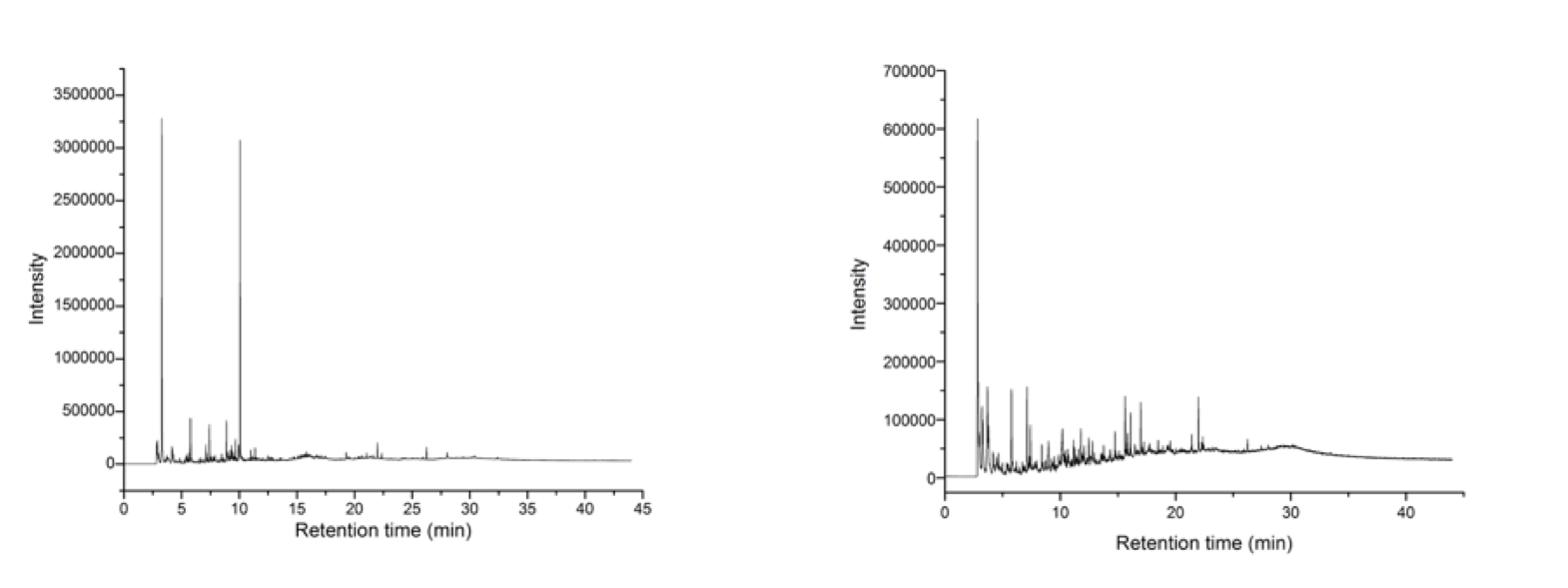
Attenuated Total Reflectance (ATR) FTIR was conducted on the four samples and their spectra were analyzed to identify the composition of the bulk mold material. Given the function of the mold, it was unsurprising to find traces of calcium sulfate in the spectrum. Subtracting the regions corresponding with calcium sulfate, a spectrum search was run, but the Infrared and Raman User Group (IRUG) database did not yield a convincing match. This is perhaps due to the overall age and degradation of the samples and/or the lack of elastomers in the database. Therefore, functional groups in the spectra allowed some tentative conclusions to be drawn. In the spectrum acquired from least degraded samples there was a strong peak that matches a peak at 835cm-1 expected of natural rubber. Consistent with the degradation of natural rubbers, this peak disappears in the more degraded samples, suggesting that a component of the original material is rubber. Overall, the peaks become less defined as the degradation advances, with the exception of the peaks in the carbonyl stretch region around 1700cm-1 that increased, confirming the mechanism of elastomer degradation through oxidation.
Scientific analysis was continued in collaboration with the Department of Scientific Research at the Metropolitan Museum of Art. Research Scientist Dr. Federica Pozzi performed the Py-GC/MS analysis of the mold samples, since other analytical techniques available to us cannot determine the possible fillers, plasticizers, stabilizers or other additives present. The Py-GC/MS chromatogram produced from the least degraded sample suggested the presence of D-limonene, a solvent used to smooth wax molds and other wax-based sculpting mediums, and to clean the leftover wax off the working surface. These results did not appear to be consistent with the archival documentation which did not provide any evidence of wax used in the creation of the sculptures. Further Py-GC/MS would have required a sample taken from the interior of the mold, which was not authorized by the curators.
Ultimately, the proprietary nature of manufacture made it difficult to identify through analysis alone the compositions of modern materials. It was very clear that the exact mold material would not be identified through either archival research or scientific analysis, but these techniques provided enough information about the object’s composition to create more suitable housing.
3D Scanning
In addition to the digital model used to create the housing, 3D scanning provided further applications. 3D scanning offered detailed documentation of the condition of the interior and exterior surfaces of the object in its current state. Having a 3D scan that documents the entire surface was a huge improvement from the documentation on file which was limited to five photographic views of the exterior and one view of the interior. Also, these scans ideally captured the current state of degradation of the entire surface of the object through texture mapping— a level of detail that photography alone could not achieve. The drawback to using 3D scans as a form of documentation is the lack of accessibility due to the dependency on expensive, proprietary software. Dependencies on proprietary software and non-archival file formats is a common issue faced in the field of time-based media conservation. Following established practices developed in the field, files were created and retained based on the likelihood of future support for proprietary software, and the widespread acceptance and archival quality of the file formats. The raw scans created by the Artec scanner (.sproj), Adobe Photoshop texture mapping (.psd) and the Zbrush project file (.ztl) are analogous to raw and edited video footage. These proprietary formats are not preservation-quality, but are considered “master” material as they are the files that were created by LaGuardia Studio for viewing the model in its full detail. An object (.obj) file was created from the Zbrush project as it one of the most widely supported geometry formats that also retains texture mapping (with associated .mtl and .jpeg files). Additional file formats were considered and created, as standard procedures for the digital preservation of 3D scans are currently being developed in collaboration between technicians, software companies and the digital preservation communities, with the goal of providing access to these models in the near future. The 3D scan has been made available by uploading to a 3D model-sharing platform, Sketchfab.
Subsequent steps include working with a mechanical engineer to identify the areas of risk that the mold is experiencing in its new housing, which can be visualized by false color imaging through the analysis of the 3D model produced. Also this model could be imported to specialized commercial software programs to take virtual cross-sections and compare the relative thickness of the material and see if it correlates to areas of degradation. And finally, one of the most exciting prospects will be an ambitious collaborative effort involving the 3D scanning of one of the finished plaster artworks and comparing that to a 3D scan of the interior of the mold. Deformations and shrinkage that the mold has undergone in the last 35 years can then be evaluated through deviation studies. Collectors who own Metamorphosis heads have been identified, and plans to gain access to the works are in progress.

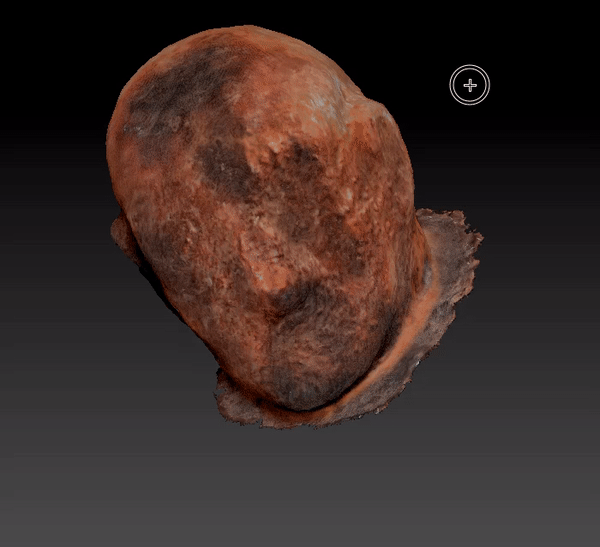

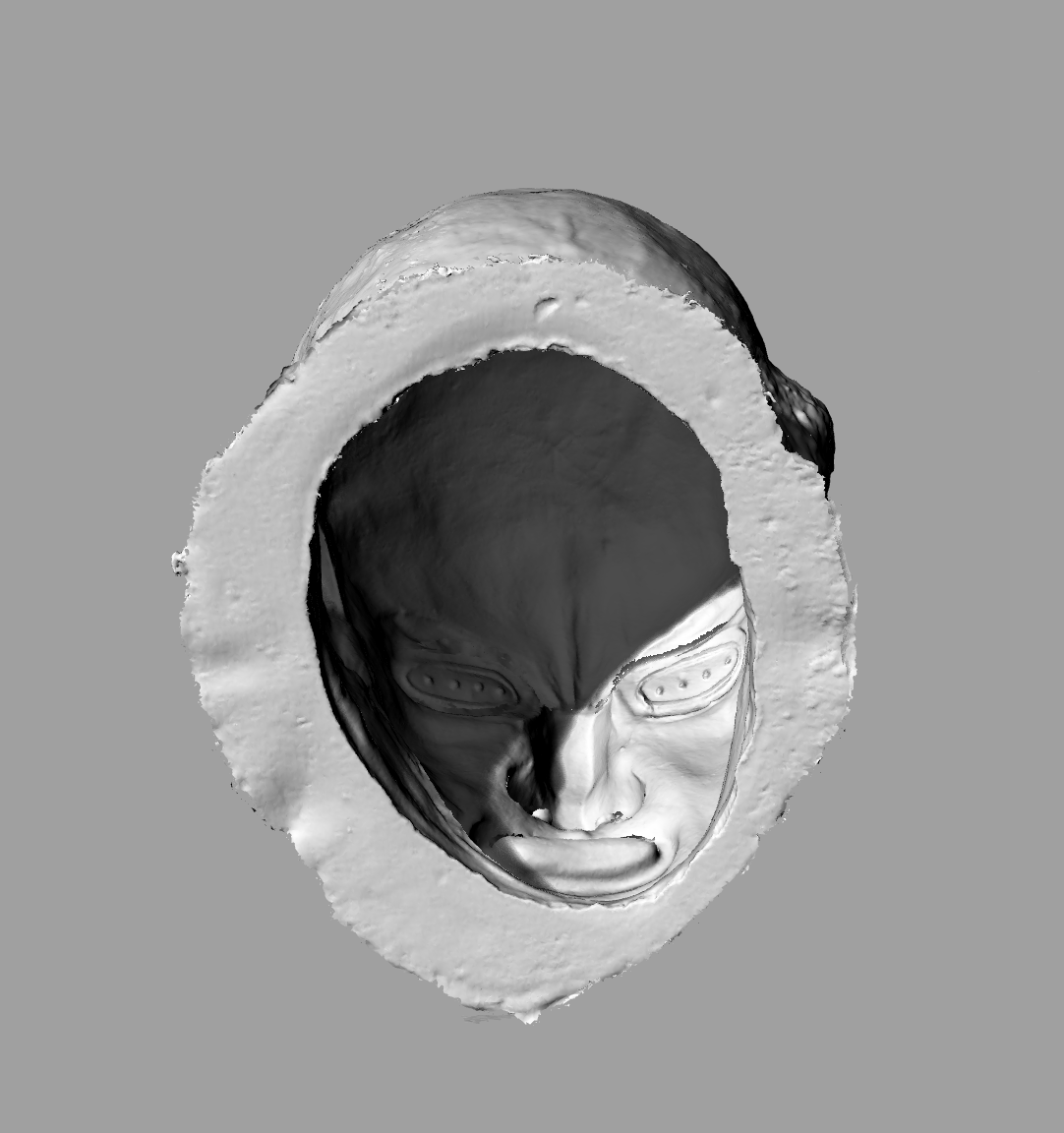
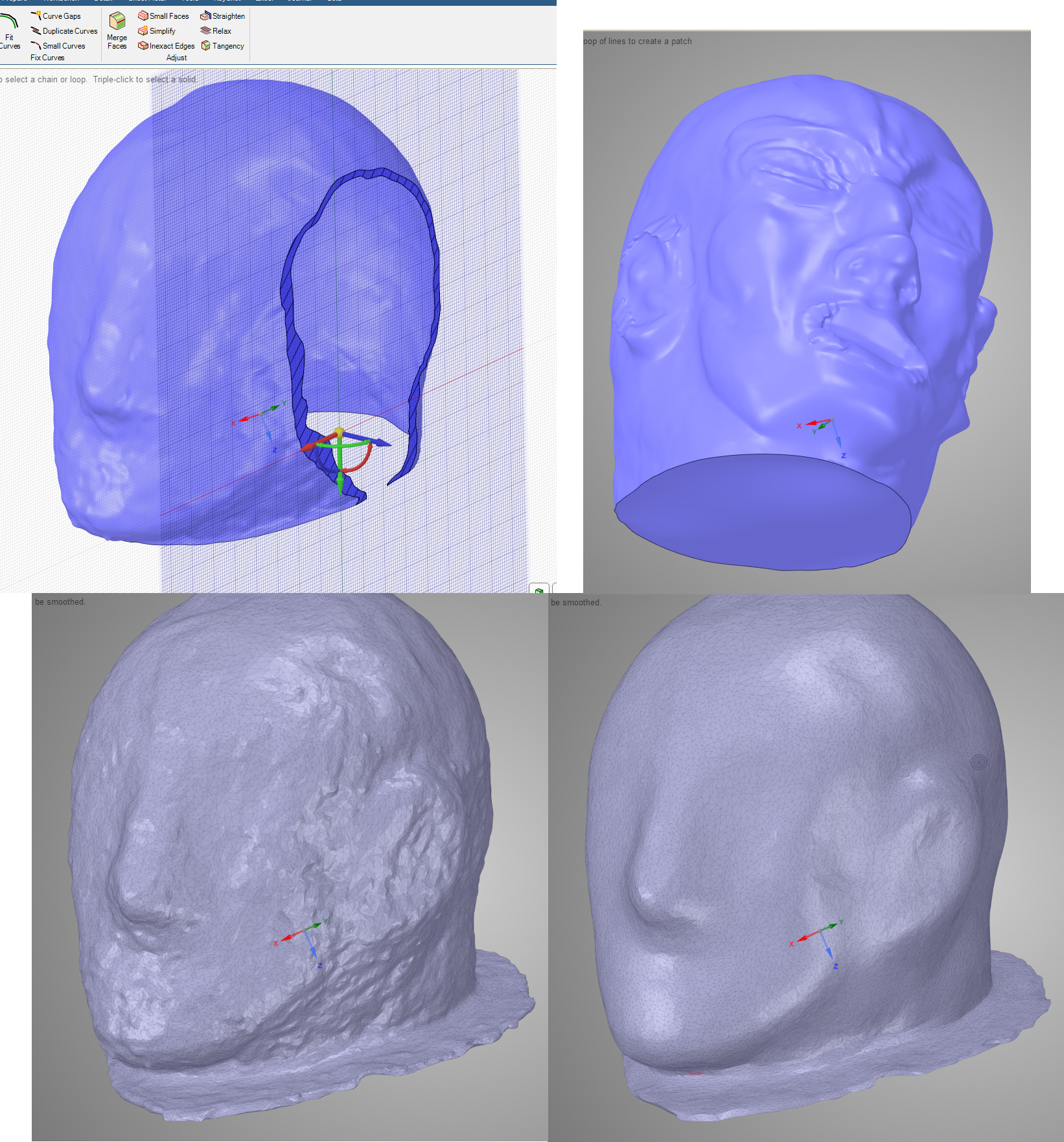
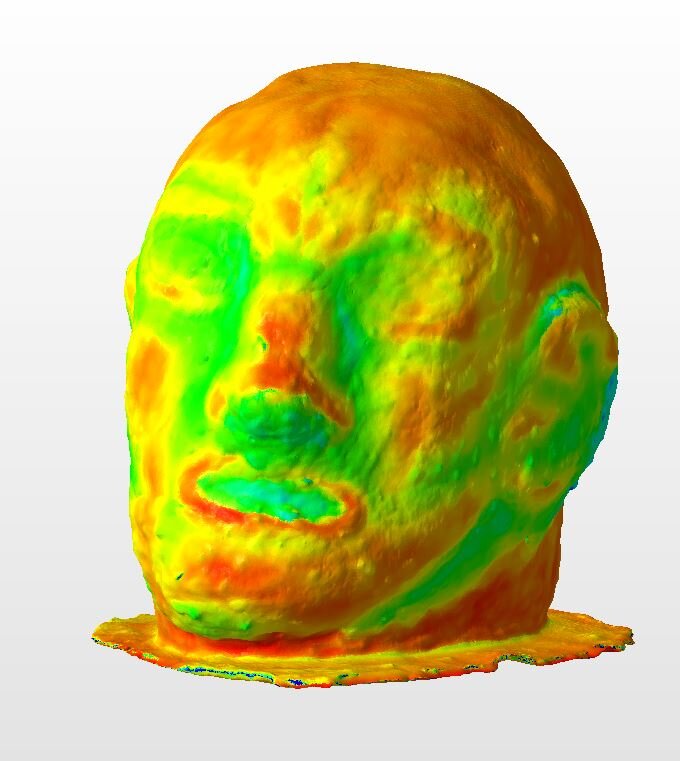
This research was presented at the following events:
The Conservation of Modern and Contemporary Art Symposium, Dedalus Foundation, New York City, October 24, 2019. Click here for recorded presentation
NYU Institute of Fine Arts Donor Luncheon, April 25, 2019
45th Annual ANAGPIC Student Conference, UCLA Getty, Los Angeles, California, March 12, 2019

